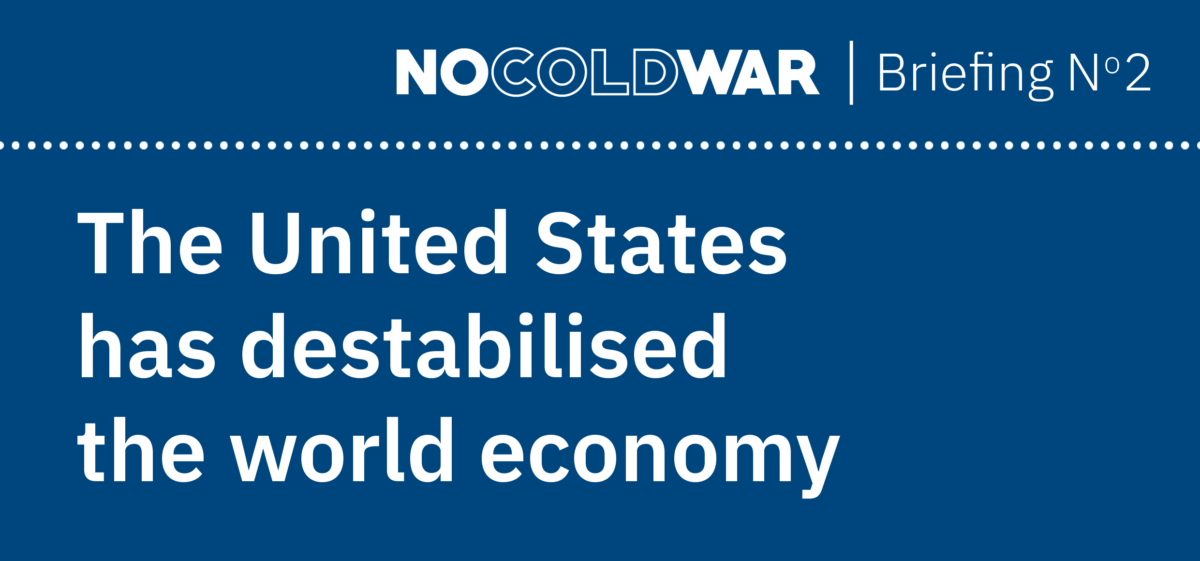The New Cold War is rapidly heating up, with severe consequences for people around the world. Our series, Briefings, provides the key facts on these matters of global concern.
The International Monetary Fund has announced that the global economy is entering a major slowdown, downgrading the growth prospects of 143 countries. At the same time, inflation rates have reached historic levels. Around the world, hundreds of millions of people are falling into poverty, particularly in the Global South. Oxfam has sounded the alarm that we are ‘witnessing the most profound collapse of humanity into extreme poverty and suffering in memory’. What is producing this immense human suffering?
An Economic Crisis ‘Made in Washington’
On 13 April, US Treasury Secretary Janet Yellen claimed that this global economic deterioration was due to the Russian war in Ukraine. This is factually incorrect. Although the conflict has worsened the situation, the key driver which has destabilised the world economy is the massive inflationary wave that had already built up in the United States and has now begun to crest on the world. Prior to the war in Ukraine, US inflation had already tripled in recent years from 2.5% (January 2020) to 7.5% (January 2022) before accelerating further to 8.5% (March 2022) after the war broke out.
‘This isn’t Putin’s inflation’, the Wall Street Journal editorial board noted. ‘This inflation was made in Washington’.
The US consumer market absorbs a fifth of the world’s goods and services; as the demand for these goods outstrips the global supply, the tendency for US inflation to spread around the world is very high. The average Commodity Research Bureau Index, a general indicator of global commodity markets, has risen astronomically: as of 25 April, year-to-year prices have soared for oil (60%), palm oil (60%), coffee (56%), wheat (45%), natural gas (139%), and coal (253%). These price increases have sent shock waves through the global economy.
This instability is inseparably connected to US economic policy. Since 2020, the United States has increased its budget by $2.8 trillion. To finance this budgetary expansion, the US government increased borrowing to 27% of the gross domestic product (GDP), and the Federal Reserve Bank increased the money supply (the quantity of money issued) by 27% year-on-year. Both of these increases are the highest in US peacetime history.
These huge US economic packages were generated to put cash in the hands of consumers. The US government focused on the economy’s demand side by putting money into circulation for consumption, but it did not increase spending on the economy’s supply side by putting money into investment. From 2019–21, 98% of US GDP growth was in consumption, while only 2% was in net investment. With a large increase in demand by consumers and almost no increase in supply, a huge inflationary wave grew in the United States.
Investing in Guns or People?
Inflation in the United States, which has global implications, is a by-product of its economic priorities. For the past half-century, US governments have not used the country’s social wealth to make substantial social investments in areas such as education, healthcare, and infrastructure, nor have they invested in the manufacturing sector to increase supply. Instead, to manage inflation the government has chosen to push an agenda which cuts demand. These cuts in demand have already lowered living standards; for instance, real wages in the United States have fallen by 2.7% in the past year.
Instead of making social investments to prevent such economic downturns, the US government has prioritised its military, which receives a budget increase every year. In 2022, the Biden administration proposed a military budget of $813 billion, a 9.2% increase over the military budget in 2021 – larger than the next eleven highest spending countries combined. To justify this massive expenditure, the Biden administration, like the Trump administration before it, has invoked the need to ‘combat threats’ posed by China and Russia.
A reduction in US military spending would free up government funds to invest in education, healthcare, infrastructure, and manufacturing. However, this would necessitate a shift in US foreign policy, which does not appear to be on the horizon. Until that time, the people of the United States and other countries will have to sustain the costs of Washington’s new Cold War.
